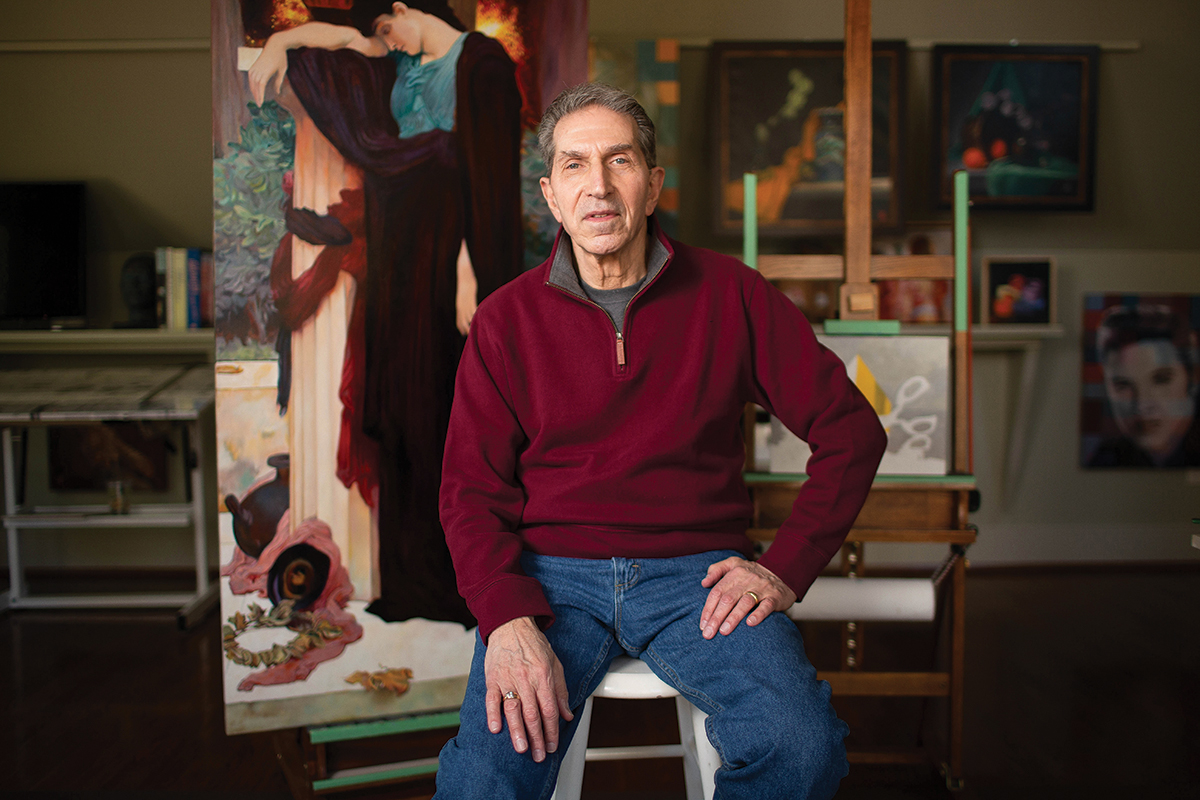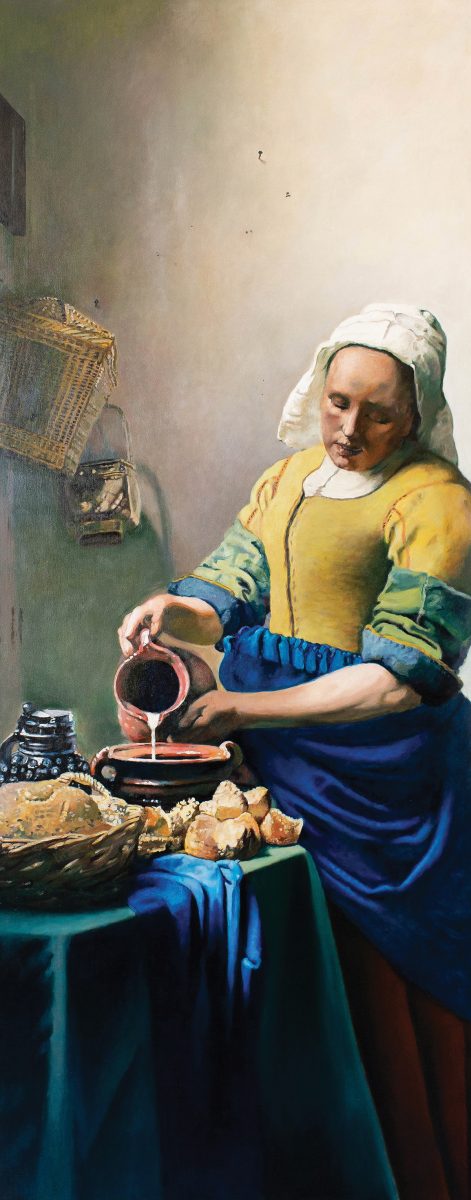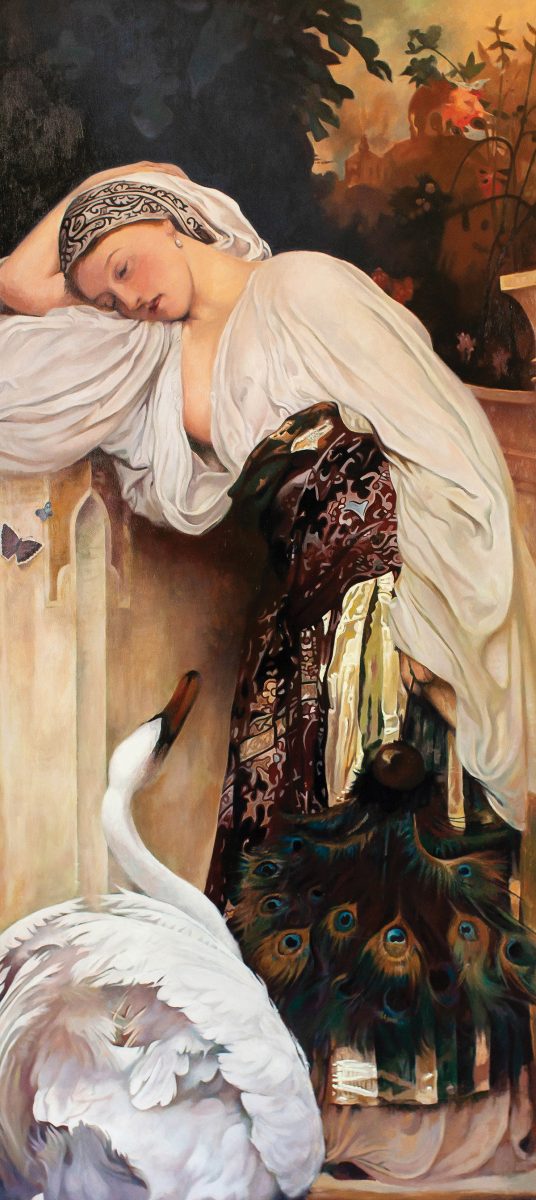Painter aims for “perfection” in recreating famous works on doors

Bill George takes all the time he needs to make master copies.
Photo by Colby Rabon
Asheville painter Bill George is a time traveler.
He’s gone back to the 17th century to ghost-apprentice under Johannes Vermeer, a Dutch Baroque Period painter celebrated for his compositions of domestic life. Some 200 years later, he “visited” Frederic Leighton, leader of the Victorian classical school of painting. George then turned to domestic creatives, studying under the specter of John White Alexander, a famed American illustrator of the late 1800s.
But how can a Buncombe County man living in this century learn firsthand from the old masters? The answer, says George, is through meticulous emulation.
George reproduces eminent works from the Early Renaissance to the Romantic movement. These master copies are painted with such precision that many take six to nine months to complete. One, a replica of Leighton’s Odalisque, demanded an entire year. “When producing a master copy, most people don’t aim for perfection; they aim for interpretation,” says George. “I had something else in mind.”

Authenticity is key. So much so that, in keeping with the medieval tradition of painting on wood (also called panel painting), George uses lightweight hollow-core doors as his canvas. Though the ancients would use unwieldy slabs — Leonardo da Vinci, for instance, preferred oak — George sticks to doors because they are much lighter. Even then, working with a seven-foot-tall piece of wood requires finesse.
Before George begins painting, he seals the door with a clear varnish. “Otherwise, the tannin from the wood will seep through and destroy the artwork,” he warns. From there, he applies two to three coats of gesso, a mixture made of chalk, gypsum, and pigment. “Preparing the door is a fairly easy process,” says George.
Sourcing his reference materials — high-quality photographs or scans of 300-year-old oil paintings — is another story. Most digital copies are pixelated or blurred. Others adulterate the original colors. Take Vermeer, for instance: “His colors glow. He would layer colors one after the other until he achieved this luminous glaze,” says George, who spent his formative years in New York City and “practically lived” at the Metropolitan Museum of Art.

Much like Vermeer, George has dedicated his life almost exclusively to art. When he was six or seven, he drew portraits of relatives at the dinner table. Anyone who visited his family home in Brooklyn became a prime subject. “My father said I started drawing when I was in the crib,” George remembers. After attending the High School of Art and Design on 56th Street, he secured a job at an illustration firm. He also started taking classes at the Art Students League of New York and, later, the Frank J. Reilly School of Art.
In 1982, George established a graphic-design firm on Madison Avenue that he and his wife would manage for more than two decades. But when the couple retired to Asheville ten years ago— a friend suggested the North Carolina mountains — George stepped away from graphic design and focused his efforts on painting.

For five years, he studied at the now-defunct Fine Arts League of the Carolinas, a nonprofit established to preserve centuries-old techniques. It was there, on Depot Street, that George truly saw the methods of Vermeer, Leighton, and Alexander.
“I wanted to paint exactly how they would,” says George. “Copying is the best way to learn from the masters … it’s like being in their studio and assisting them.”
The artist has sold two of his six completed doors; he says he “paints what inspires him,” though he does accept commissions. George’s other works include luscious oil-on-linen food paintings and still lifes (flowers, toys, arranged objects); portraits of iconic figures infused on aluminum; and landscapes. His famous, bygone mentors are always close at hand, guiding his process “down to the direction of the brushstrokes.”
Bill George, Asheville. The artist’s still lifes and other paintings are represented by Asheville Gallery of Art (82 Patton Ave., ashevillegallery-of-art.com). For more information about George’s art doors, visit billgeorge.net.
